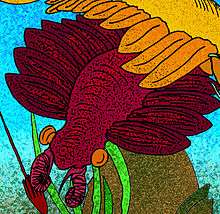Dinocaridida
| Dinocaridida Temporal range: Cambrian–Middle Devonian | |
|---|---|
 | |
| Amplectobelua symbrachiata | |
| Scientific classification | |
| Kingdom: | Animalia |
| Subkingdom: | Eumetazoa |
| (unranked): | Bilateria |
| Superphylum: | Ecdysozoa |
| (unranked): | Panarthropoda |
| Class: | Dinocaridida |
| Genera | |
Dinocaridida[derivation 1] is a proposed extinct taxon[1] of fossil arthropod-like marine animals found, with one exception, in the Cambrian and Ordovician.[2] It is subdivided into the anomalocaridids and the opabinids. The name of this group comes from Greek, "deinos" and "caris", meaning "terror shrimp" or "terror crab", due to their crustacean-like appearance and the hypotheses suggesting that members of this class were the apex predators of their time.
Dinocaridids are bilaterally symmetrical, with a non-mineralized cuticle and a body divided into two major tagmata, or body-sections. The frontal section have two claws found just in front of the mouth, which is located on these creatures' underside. The body will possess thirteen or more segments, each with its own gill branch and swimming lobe. It is thought that these lobes moved in an up-and-down motion to propel the animal forward [3] in a fashion similar to the cuttlefish.
The placement of Dinocaridida is uncertain: they appear to be a stem group to arthropods. In some recent works they are grouped with other enigmatic forms in the phylum Lobopodia.[4]
The group is geographically widespread, and has been reported from Cambrian strata in Canada, China and Russia,[5] as well as the Ordovician of Morocco and Devonian of Germany.[6]
Notes
- ↑ Greek, "Terrible crabs" – sometimes informally spelt Dinocarida, but the second 'id' is linguistically correct – see Hou, Xianguang; Bergström, Jan; Jie, Yang (2006). "Distinguishing anomalocaridids from arthropods and priapulids". Geological Journal. 41 (3–4): 259–269. doi:10.1002/gj.1050.
References
- ↑ Collins, D. (1996). "The "Evolution" of Anomalocaris and Its Classification in the Arthropod Class Dinocarida (nov.) and Order Radiodonta (nov.)". Journal of Paleontology. 70 (2): 280–293. doi:10.2307/1306391. JSTOR 1306391.
- ↑ Van Roy, P.; Briggs, D. E. G. (2011). "A giant Ordovician anomalocaridid". Nature 473 (7348): 510–513. doi:10.1038/nature09920. edit
- ↑ Usami, Y. (2006). "Theoretical study on the body form and swimming pattern of Anomalocaris based on hydrodynamic simulation". Journal of Theoretical Biology. 238 (1): 11–17. doi:10.1016/j.jtbi.2005.05.008. PMID 16002096.
- ↑ Budd, G. E. (1996). "The morphology of Opabinia regalis and the reconstruction of the arthropod stem-group". Lethaia. 29: 1. doi:10.1111/j.1502-3931.1996.tb01831.x.
- ↑ Ponomarenko, A. G. (2010). "First record of Dinocarida from Russia". Paleontological Journal. 44 (5): 503–504. doi:10.1134/S0031030110050047.
- ↑ Kühl, G.; Briggs, D. E. G.; Rust, J. (Feb 2009). "A Great-Appendage Arthropod with a Radial Mouth from the Lower Devonian Hunsrück Slate, Germany". Science. 323 (5915): 771–3. Bibcode:2009Sci...323..771K. doi:10.1126/science.1166586. ISSN 0036-8075. PMID 19197061.
| Wikispecies has information related to: Dinocaridida |